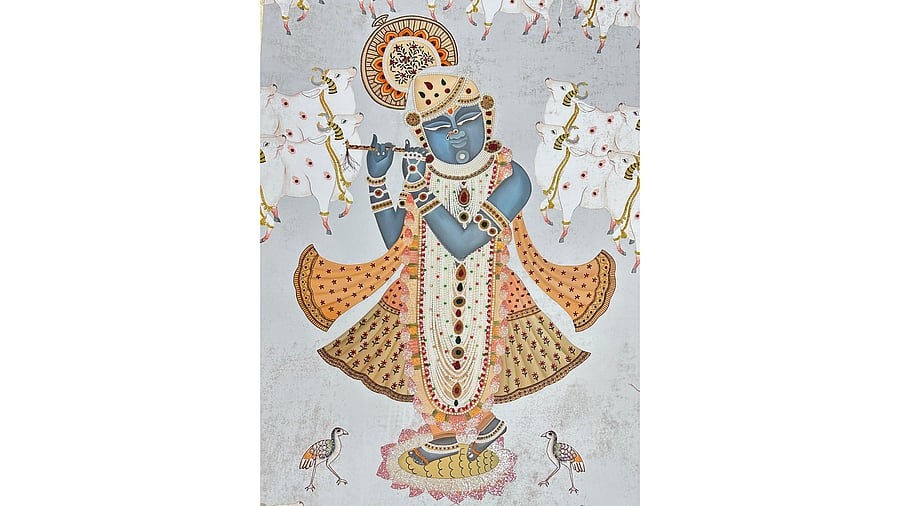
An embroidered wallpaper with silk threads, cutdana, antique beads and touches of gold.
Credit: UDC Homes
Designers today are revisiting the tales of Krishna they grew up with, but through a personal and modern lens. Instead of sticking to scripture-bound visuals, they’re blending mythic figures and ancient cities with childhood memories and emotions. These reimaginings take shape on everyday walls and modern canvases. For her latest series, Surbhi N Bangla, founder of Chitrakaari—a design studio specialising in wall art—brings together the Pichwai tradition and her own childhood experiences: memories of temple visits, her grandmother’s Krishna stories, and the rituals she observed growing up. She aimed to translate those impressions into contemporary design. In this, Mathura is reimagined—not as a place, but as a feeling, as she puts it. The wallpapers unfold like murals— showing shrines, trees, and cows, framed by jharokhas and temple arches. Designed especially for homes, the artworks reinterpret temple iconography in a modern format—lending a fresh colour palette and illustrative detailing.
In one of the collection’s standout pieces—an embroidered portrait of Krishna— Chitrakaari’s Chief Designer Lahari Ashwin blends two iconic forms of the deity: Bihariji, the Vrindavan Krishna known for his expressive eyes and romantic posture, and Shrinathji, the Nathdwara figure shown lifting Mount Govardhan. The design draws on cues from both—gestures, turban styles, and jewellery — to craft a single contemporary version.
Multiple traditions
The embroidered portrait of Krishna brings together multiple regional traditions—Pichwai iconography, Banarasi brocade textures, Zardozi (raised gold thread work), and Aari (fine chain-stitch embroidery). It’s hand-drawn, then printed on silk, and layered with 3D leaves and flowers made from glass beads and pearls. Chitrakaari’s wallpapers are also first-hand-drawn, then digitised and printed on textured paper. Departing from the rigid symmetry of traditional Pichwai, the compositions introduce soft imbalances—trees that don’t match, cows placed a little off—letting it feel more instinctive. Their choice for a subdued palette lends a dreamy feel. One wallpaper captures the gardens of Vrindavan with flowering trees, lingering peacocks, and arched pavilions. Another celebrates Krishna’s cowherd days, with cows standing among pink lotuses and fruiting trees against a vivid yellow lattice.
A unique Pichwai detail here: handprint motifs, inspired by the ancient practice of placing turmeric-dipped palms on cows in prayer.
A matter of interpretation
Neha Jain’s wall art studio, UDC Homes, takes the storytelling through Pichwai-inspired wall art a step further. Her work leans into mood and suggestion. “We wanted to build mural wallpapers that unfold like stories,” she says. Each of Neha’s designs begins as a hand-drawn illustration with flexible elements that can be rearranged and expanded to suit walls of any size. In this series, Krishna isn’t always seen—he’s implied. The idea was to leave just enough mystery — to imagine not just how one might have seen Krishna, but what Krishna might have seen in his world.
One mural unfolds in a palace courtyard, rich with architectural detail and a vast landscape, where gopis (cowherd girls) dance and linger. The second captures an everyday scene—a gopi indoors playing with a calf, while another reaches up to pick fruit from a tree, echoing Krishna’s gentle mischief. Krishna remains absent from both—his presence reserved for a separate embroidered wallpaper.
In that wallpaper, much like Chitrakaari’s take, Neha blends traditional styles to shape her interpretation. She draws on Nathdwara art for Krishna’s form and ornamentation, and Pichwai for the posture and storytelling elements. The piece stands out for its detailed hand embroidery — silk threads, cutdana (tiny glass tubes), antique beads, and touches of gold. Each mural is composed like a visual meditation, evoking a scene from Krishna’s life. Manuel Sebastian, founder of Creative Art Studio, brings a similar narrative richness into a modern dining space. Manuel’s version of Vrindavan unfolds as a sculpted wall relief made entirely from cement — Radha and Krishna on a swing, surrounded by cows, peacocks, trees, and clouds. Unlike traditional mural or fresco approaches, this work uses a unique technique to shape its form.
Sebastian began by sketching the full scene directly onto the wall. Then, to achieve the sculptural projection, he cut holes at key points—where Radha and Krishna would sit—and a supporting structure of rods and mesh was inserted to push their forms outward. “Layer by layer, cement was applied and sculpted by hand, followed by a smooth coating of putty,” he shares.
The final work uses muted tones and soft lighting to create a calm, immersive atmosphere.
Be it embroidered wall art, sculpted reliefs, or digitally rendered expansive murals, designers are shifting how the myth of Krishna is experienced. It’s no longer about placing a deity in a frame, but about letting the epic unfold across walls and rooms.